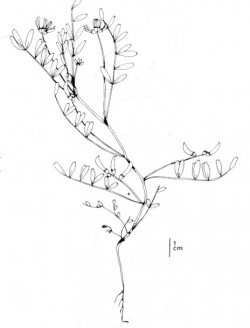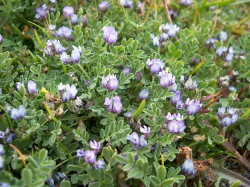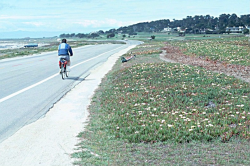
endangered

Illustration from Abrams (1944).

Photo taken along 17-Mile Drive © 2004 Bob Huettmann.

Photo taken along 17-Mile Drive © 2001 Dean W. Taylor.



This fact sheet was prepared by Grey F. Hayes, Dean W. Taylor, and Dylan M. Neubauer under award NA04N0S4200074 from the National Oceanic and Atmospheric Administration (NOAA), U.S. Department of Commerce (DOC). The statements, findings, conclusions, and recommendations are those of the authors and do not necessarily reflect the views of the NOAA or the DOC.
© Copyright 2006, Elkhorn Slough Coastal Training Program
Last updated: Jan 30, 2015 11:18
Common Names - coastal dunes milk vetch
Family - Fabaceae (Legume Family)
State Status - state endangered
(February 1982)
Federal Status - federal endangered
(August 1998)
Habitat
Disturbed coastal prairie on deep heavy clay soil of wave terrace or vernally moist dune hollows.
Key Characteristics
Delicate, ascending to erect, greenish annual to ca. 1 dm tall; stems sparsely strigose to subglabrous; leaflets 7–13, lanceolate to obovate, 2–16 mm long and ca. 4 mm wide, with slight indentation at tip (important for identification); peduncles 2–4 cm long; inflorescence dense, up to 7-flowered; calyx tube 2 mm long, black-hairy; petals pink-purple, banner 5–6 mm long and often with darker veins; wings and keel with darker purple bases; pods straight or curved, 6–14 mm, on reflexed peduncle, lacking a stipe, ovules 5–11 (Wojciechowski and Spellenberg 2013). Distinguished from A. tener var. tener (with California Rare Plant Rank 1B.2) by banner size, ovule number, and its coastal (vs. inland) habitat.
Flowering Period
March to May
Reference Population
17-Mile Drive, Monterey County, 5–10 yards outside south side of Enclosure (between Point Joe and Bird Rock) along walking trail.
Global Distribution
Historically, populations occurred in southern coastal San Diego, coastal and near coastal Los Angeles, and on the Monterey Peninsula in Monterey County (Moss Beach and Pebble Beach). Currently, it is only known from one highly fragmented population located on a coastal terrace grassland along a one-mile stretch of 17-Mile Drive in Pebble Beach (CNPS 2010).
Barneby (1964) reported a collection labeled as "San Luis Obispo," however the exact location has not been identified (Liston, pers. com.), nor is it reflected in CNDDB or CNPS records, and the location was not known to Hoover (1970). Contrary to the statement in Barneby (1964), the type locality "Moss Beach near Spanish Bay" is not the same location as present day Moss Landing. The known distribution suggests this small herb might occur on the Big Sur coast; field searches are needed.
Conservation
The 17-Mile Drive population in Monterey County is comprised of scattered patches on both sides of the road (USFWS 2009) in an area that receives heavy recreational use and where competition from exotic plants occurs.
Annual counts have varied between less than 100 individuals to approximately 7,000, depending on climatic conditions in winter and early spring when germination occurs (USFWS 2009). An Enclosure was built many years ago to protect the plant, though plants have not been seen inside the fenced area in 2014 or 2015 (Huettmann, pers. comm.). Sea-level rise and storm surge have greatly affected the colonies on the seaward side of 17-Mile Drive (C. Rutherford, pers. comm.).
Studies conducted in 1998 indicate that the plant may be less restricted in its habitat requirements than previously thought. It appears to do well in areas of low cover and low-level disturbance—including that created by gophers and light pedestrian traffic. In addition, as the species self-pollinates successfully, pollinators are not a major concern in the establishment and maintenance of populations (Doak et al. 2000). However, the small numbers of individuals and the small geographic area they occupy contribute to the extreme vulnerability of this species (USFWS 2009).
References
Abrams, L. R. 1944. Illustrated flora of the Pacific States, Vol. II. Stanford University Press, Palo Alto, CA.
Barneby, R. C. 1964. Atlas of the American Astragalus. Memoirs of the New York Botanical Garden 13:1–1188.
California Natural Diversity Database (CNDDB). 2010. California Department of Fish and Wildlife RareFind 5. http://www.dfg.ca.gov/biogeodata/cnddb/mapsanddata.asp [accessed 6 January 2015].
CNPS, Rare Plant Program. 2010. Astragalus tener var. titi, in Inventory of Rare and Endangered Plants (online edition, v8-02). California Native Plant Society, Sacramento, CA. http://www.rareplants.cnps.org/detail/343.html [accessed 7 January 2015].
Doak, D., J. Borgeson, S. Danner, A. Graff, M. Kauffman, P. Shahani, and D. Thomson. 2000 (unpublished). Final report for rare plant management projects: Ecological factors affecting the recovery of coastal milk vetch (Astragalus tener var. titi, Fabaceae), Hickman's cinquefoil (Potentilla hickmanii, Rosaceae), and Pacific Grove clover (Trifolium polyodon, Fabaceae). Prepared for California Department of Fish and Game. http://www.co.monterey.ca.us/planning/major/Pebble%20Beach%20Company/Pebble_Beach_DEIR_Nov_2011/Pebble_Beach_DEIR_Admin_Records_Nov_2011/Jones_Stokes/JS_1996_FinalRecoveryStratSixPlantSpecies.pdf [accessed 5 January 2015].
Hoover, R. E. 1970. The vascular plants of San Luis Obispo County, California. University of California Press, Berkeley, CA.
Huettmann, B. Personal communication [19 March 2015].
Jones and Stokes Associates, Inc. 1996. Final recovery strategies for six coastal pant species on the Monterey Peninsula. Prepared for California Department of Fish and Game. http://www.co.monterey.ca.us/planning/major/Pebble%20Beach%20Company/Pebble_Beach_DEIR_Nov_2011/Pebble_Beach_DEIR_Admin_Records_Nov_2011/Jones_Stokes/JS_1996_FinalRecoveryStratSixPlantSpecies.pdf [accessed 5 January 2015].
Rutherford, C. Personal communication [March 2015].
U.S. Fish & Wildlife Service (USFWS). 2004. Recovery plan for five plants from Monterey County, California. Region 1, Portland, Oregon. http://ecos.fws.gov/docs/recovery_plan/050617a.pdf [accessed 5 January 2015].
U.S. Fish & Wildlife Service (USFWS). 2009. Astragalus tener var. titi (Coastal Dunes Milk-vetch) 5-year review: summary and evaluation. Ventura Fish and Wildlife Office, Ventura, CA. http://ecos.fws.gov/docs/five_year_review/doc2382.pdf [accessed 5 January 2015].
Wojciechowski M. F. and R. Spellenberg. 2013. Astragalus, in Jepson Flora Project (eds.) Jepson eFlora http://ucjeps.berkeley.edu/cgi-bin/get_IJM.pl?tid=54951 [accessed 5 January 2015].
Reviewers
Bob Huettmann, Connie Rutherford, USFWS (March 2015).
